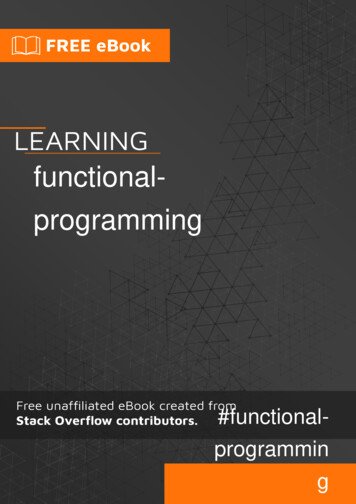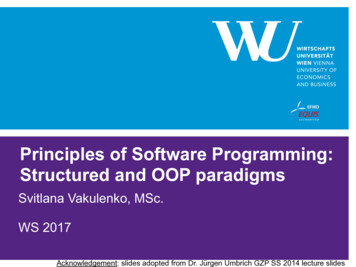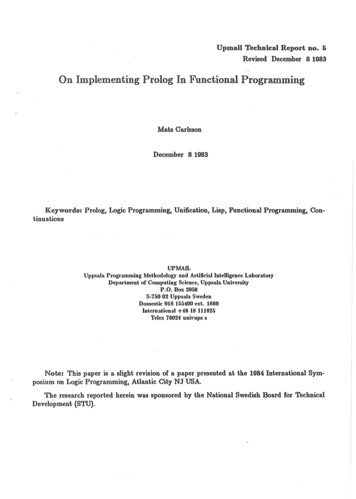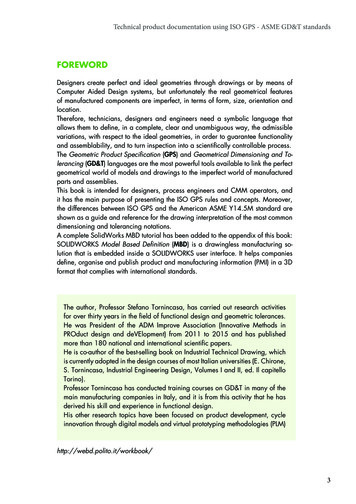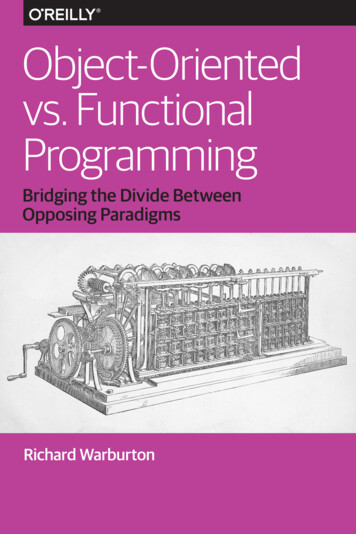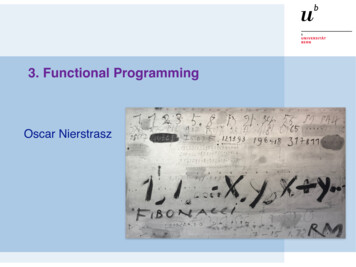
Transcription
3. Functional ProgrammingOscar Nierstrasz
Roadmap Functional vs. Imperative Programming Pattern Matching Referential Transparency Lazy Evaluation Recursion Higher Order and Curried Functions
References “Conception, Evolution, and Application of Functional ProgrammingLanguages,” Paul Hudak, ACM Computing Surveys 21/3, 1989, pp359-411. “A Gentle Introduction to Haskell,” Paul Hudak and Joseph H. Fasel— www.haskell.org/tutorial/ Haskell 2010 Language Report— www.haskell.org Real World Haskell, Bryan O'Sullivan, Don Stewart, and JohnGoerzen— book.realworldhaskell.org/read/3
Conception, Evolution, and Application of FunctionalProgramming L/Huda89a-p359-hudak.pdfA Gentle Introduction to Haskellhttps://www.haskell.org/tutorial/Haskell 2010 Language 2010/Real World Haskellhttp://book.realworldhaskell.org
Roadmap Functional vs. Imperative Programming Pattern Matching Referential Transparency Lazy Evaluation Recursion Higher Order and Curried Functions
A Bit of HistoryLambda Calculus(Church, 1932-33)Lisp(McCarthy, 1960)formal model of computationsymbolic computations with listsAPL(Iverson, 1962)algebraic programming with arraysISWIM(Landin, 1966)let and where clauses; equational reasoning;birth of “pure” functional programming .ML(Edinburgh, 1979)originally meta language for theorem provingSASL, KRC, Miranda(Turner, 1976-85)Haskell(Hudak, Wadler, et al., 1988)lazy evaluation“Grand Unification” of functional languages .5
Church’s lambda calculus predates computers, but is aninfluential early model of computation that has deeply influencedprogramming language design.Lisp is a language that unifies data and programs. Functions arerepresented as lists that resemble lambda expressions and are theninterpreted or compiled.APL is a language for manipulating arrays and arrays of arrays.Programs are built up of functional operators applied to arrays.Later languages like Mathematica owe a great deal to APL.ISWIM is a paper language design that has strongly influencedthe design of functional languages like Haskell.ML was designed as a theorem-proving meta-language, butended up being a general purpose functional language.Miranda and friends introduced “lazy evaluation” to thefunctional paradigm, though the idea dates from lambda calculus.Haskell unified and cleaned up many of these ideas.
Programming without StateImperative style:n : x;a : 1;while n 0 dobegin a: a*n;n : n-1;end;Declarative (functional) style:fac n ifthenelsen 01n * fac (n-1)Programs in pure functional languages have no explicit state.Programs are constructed entirely by composing expressions.6
Note that the functional style resembles much more the typicalmathematical (i.e., declarative) definition.
Pure Functional Programming LanguagesImperative Programming: Program Algorithms DataFunctional Programming: Program Functions o FunctionsWhat is a Program?—A program (computation) is a transformation from input data tooutput data.7
Key features of pure functional languages1.2.3.4.5.All programs and procedures are functionsThere are no variables or assignments — only inputparametersThere are no loops — only recursive functionsThe value returned by a function depends only on thevalues of its parametersFunctions are first-class values8
Note that early functional languages like Lisp, APL and ML arenot “pure”, that is they allow programs to have a modifiable state.Similarly Scala, a fusion of functional and object-orientedprogramming, is necessarily impure, as it builds on Java.Nevertheless, it is possible to write pure (stateless) programs evenin impure languages.
What is Haskell?Haskell is a general purpose, purely functionalprogramming language incorporating many recentinnovations in programming language design. Haskellprovides higher-order functions, non-strict semantics,static polymorphic typing, user-defined algebraicdatatypes, pattern-matching, list comprehensions, amodule system, a monadic I/O system, and a rich set ofprimitive datatypes, including lists, arrays, arbitrary andfixed precision integers, and floating-point numbers.Haskell is both the culmination and solidification of manyyears of research on lazy functional languages.— The Haskell 98 report9
The highlighted phrases are key:Haskell is intended to be a general-purpose, i.e., practical,language for arbitrary application domains. At the same time it ispurely functional (i.e., stateless), so it is an explicit challenge todemonstrate that such languages can be practical.Higher-order functions treat functions as first-class values, so cantake functions as arguments and can yield functions as returnvalues.Non-strict semantics (as we shall see) means that expressions areevaluated lazily, i.e., values are only computed as needed. Thisenables highly expressive language features such as infinite lists.
Static polymorphic typing means (i) that programs are staticallytype-checked, i.e., before running them, and (ii) functions may bepolymorphic, i.e., can take arguments of different types. Inaddition, Haskell supports (ML-style) type inference: (most)programs can be type-checked even without explicit typeannotations.User-defined algebraic datatypes are abstract data types thatbundle functions together with a hidden representation (like OOclasses, but without inheritance).Pattern-matching offers a highly expressive way to definemultiple cases for function definition (similar to Prolog).Finally, list comprehensions offer a convenient mathematical setlike notation for defining lists of values.
“Hello World” in Haskellhello() print "Hello World"10
hello is a function that takes an empty tuple as an argument. Itinvokes the print function with the string (character array)“hello world” as its argument.You may well ask, “If Haskell is ‘pure’, then how can you printsomething without having a side effect?”Well, consider “output” as an infinite lazy list that is beingcomputed over time
To run Haskell programs, download and install the Glasgow Haskell Platform:https://www.haskell.org/platform/To define and run code interactively, start the ghci interpreter. You can define functions in afile and load them, or define them interactively with let:% ghciGHCi, version 7.10.3: http://www.haskell.org/ghc/ :? forhelpPrelude let hello () print "hello"Prelude hello ()"hello"Prelude :load Intro.hs[1 of 2] Compiling HUnit( HUnit.hs, interpreted )[2 of 2] Compiling Main( Intro.hs, interpreted )Ok, modules loaded: HUnit, Main.*Main fac 5120You can also change the prompt with the command:set prompt “% “
Roadmap Functional vs. Imperative Programming Pattern Matching Referential Transparency Lazy Evaluation Recursion Higher Order and Curried Functions
Pattern MatchingHaskell supports multiple styles for specifying case-based functiondefinitions:Patterns:fac' 0 1fac' n n * fac' (n-1)-- or: fac’ (n 1) (n 1) * fac’ nGuards:fac'' n n 0 n 1 1 n * fac'' (n-1)12
The evaluation order of unguarded patterns can be significant.Note that either constants or variables can appear in patterns.What happens if you try to evaluate this?:fac’ (-1)
ListsLists are pairs of elements and lists of elements: [ ] — stands for the empty list x:xs — stands for the list with x as the head and xs asthe tail (rest of the list)The following short forms make lists more convenient to use [1,2,3] — is syntactic sugar for 1:2:3:[ ] [1.n] — stands for [1,2,3, . n]13
Lists in Haskell are homogeneous, that is they can only containelements of a single type. We will discuss type in more detail inthe next lecture.
Using ListsLists can be deconstructed using patterns:head (x: ) xlen [ ]len ( :xs) 0 1 len xsprod [ ] 1prod (x:xs) x * prod xsfac''' n prod [1.n]14
The underscore ( ) is a wildcard pattern and matches anything.In the definition of head, it says, “I am interested in the value ofthe head and call it x; I don’t care what the tail is.”Note that head [1.5] head (1:2:3:4:5) 1What is head [] ?Note that len is defined recursively. Pure functional languagestend to use recursion rather than explicit loops (though loops canbe defined in Haskell as a utility function).
List comprehensionsA list comprehension uses a set-like notation to define a list:[ x*x x - [1.10]] [1,4,9,16,25,36,49,64,81,100]15
List comprehensions follow the general form:[ elements definition ]Where elements are Haskell expressions (e.g., tuples, lists etc)containing variables defined to the right.See:https://wiki.haskell.org/List comprehension
Roadmap Functional vs. Imperative Programming Pattern Matching Referential Transparency Lazy Evaluation Recursion Higher Order and Curried Functions
Referential TransparencyA function has the property of referential transparency if itsvalue depends only on the values of its parameters. Does f(x) f(x) equal 2*f(x)? In C? In Haskell?Referential transparency means that “equals can bereplaced by equals”.In a pure functional language, all functions are referentiallytransparent, and therefore always yield the same result nomatter how often they are called.17
Evaluation of ExpressionsExpressions can be (formally) evaluated by substituting arguments forformal parameters in function bodies:fac 4 if 4 0 then 1 else 4 * fac (4-1) 4 * fac (4-1) 4 * (if (4-1) 0 then 1 else (4-1) * fac (4-1-1)) 4 * (if 3 0 then 1 else (4-1) * fac (4-1-1)) 4 * ((4-1) * fac (4-1-1)) 4 * ((4-1) * (if (4-1-1) 0 then 1 else (4-1-1) * )) 4 * ((4-1) * ((4-1-1) * ((4-1-1-1) * 1))) 24Of course, real functional languages are not implemented bysyntactic substitution .18
As we shall see in the lecture on lambda calculus, the semanticsof function application can indeed be defined formally assyntactic substitution of arguments in the body of the function(while taking care to avoid name clashes).
Roadmap Functional vs. Imperative Programming Pattern Matching Referential Transparency Lazy Evaluation Recursion Higher Order and Curried Functions
Lazy Evaluation“Lazy”, or “normal-order” evaluation only evaluates expressions whenthey are actually needed. Clever implementation techniques(Wadsworth, 1971) allow replicated expressions to be shared, and thusavoid needless recalculations.So:sqr n n * nsqr (2 5) (2 5) * (2 5) 7 * 7 49Lazy evaluation allows some functions to be evaluated even if they arepassed incorrect or non-terminating arguments:ifTrue True x yifTrue False x y x yifTrue True 1 (5/0) 120
Again, as we shall see with the lambda calculus, functions caneither be evaluated strictly, by evaluating all arguments first (i.e.,especially if the arguments are complex expressions, notprimitive values), or lazily, by evaluating arguments only if andwhen they are needed.Conventional languages (like Java) are strict, while purefunctional languages are lazy. Nevertheless, one can program in alazy style in any language, even Java.Strict evaluation is also known as applicative evaluation, and lazyevaluation is known as normal order evaluation, for reasons thatwill become clear later (only normal order is guaranteed to lead toa normalized value, if one exists).
Lazy ListsLazy lists are infinite data structures whose values are generated byneed:from n n : from (n 1)take 0take [ ]take (n 1) (x:xs)take 2 (from 100)from 100 [100,101,102,103,. [ ] [ ] x : take n xs take 2 (100:from 101) 100:(take 1 (from 101)) 100:(take 1 (101:from 102)) 100:101:(take 0 (from 102)) 100:101:[] [100,101]NB: The lazy list (from n) has the special syntax: [n.]21
Lazy lists are a built-in feature of pure functional languages thatderive directly from their lazy evaluation strategy.One can easily simulate a lazy list in an OO language: define anobject that knows how to compute and return its nth value, andcaches all values computed thus far.
Programming lazy listsMany sequences are naturally implemented as lazy lists.Note the top-down, declarative style:fibs 1 : 1 : fibsFollowing 1 1where fibsFollowing a b (a b) : fibsFollowing b (a b)take 10 fibs [ 1, 1, 2, 3, 5, 8, 13, 21, 34, 55 ] How would you re-write fibs so that (a b) only appears once?22
Note that fibs is an infinite list. We can freely manipulate it, aslong as we don’t try to compute all the values. The takefunction only forces the computation of a finite subsequence, andthen “throws away” the rest.
Declarative Programming Styleprimes primesFrom 2primesFrom n p : primesFrom (p 1)where p nextPrime nnextPrime n isPrime n n otherwise nextPrime (n 1)isPrime 2 TrueisPrime n notDivisible primes nnotDivisible (k:ps) n (k*k) n True (mod n k) 0 False otherwise notDivisible ps ntake 100 primes [ 2, 3, 5, 7, 11, 13, . 523, 541 ]23
Roadmap Functional vs. Imperative Programming Pattern Matching Referential Transparency Lazy Evaluation Recursion Higher Order and Curried Functions
Tail RecursionRecursive functions can be less efficient than loops because of the highcost of procedure calls on most hardware.A tail recursive function calls itself only as its last operation, so therecursive call can be optimized away by a modern compiler since itneeds only a single run-time stack frame:fact 5 fact 5fact 4 fact 5sfac 5 sfac 4 sfac 3fact 4fact 325
Tail Recursion .A recursive function can be converted to a tail-recursive one byrepresenting partial computations as explicit function parameters:sfac s n ifthenelsen 0ssfac (s*n) (n-1)sfac 1 4 sfac (1*4) (4-1) sfac (1*4) 3 sfac (1*4*3) (3-1) sfac (1*4*3*2*1) 0 (1*4*3*2*1) . 2426
Recall that the last step of fac n was n*fac(n-1). In order totransform fac into a tail-recursive function, we must turn the restof the computation (n* ) into a parameter. This is exactly whatwe do by adding the parameter s to the function sfac: itaccumulates the progressive multiplications.In general this is what you need to do make recursive functionstail-recursive.Note that the value of s is not needed until the end, so it iscomputed lazily.
Multiple RecursionNaive recursion may result in unnecessary recalculations:fib 1fib 2fib (n 2) 1 1 fib n fib (n 1)— NB: Not tail-recursive!Efficiency can be regained by explicitly passing calculated values:fib' 1fib' nfibPair 1fibPair n 1 awhere ( ,a) fibPair n (0,1) (b,a b)where (a,b) fibPair (n-1) How would you write a tail-recursive Fibonacci function?27
Note that fibPair expresses the nth Fibonacci pair. Byencapsulating a pair of values, everything is available to computethe next pair, so only one recursive step is needed.
Roadmap Functional vs. Imperative Programming Pattern Matching Referential Transparency Lazy Evaluation Recursion Higher Order and Curried Functions
Higher Order FunctionsHigher-order functions treat other functions as first-class values that canbe composed to produce new functions.map f [ ]map f (x:xs) [ ] f x : map f xsmap fac [1.5] [1, 2, 6, 24, 120]NB: map fac is a new function that can be applied to lists:mfac l map fac lmfac [1.3] [1, 2, 6]29
Note that we can also write simply:mfac map facAs we shall see below, mfac and map are both Curried functionsthat take their arguments progressively.
Anonymous functionsAnonymous functions can be written as “lambda abstractions”.The function (\x - x * x) behaves exactly like sqr:sqr x x * xsqr 10 100(\x - x * x) 10 100Anonymous functions are first-class values:map (\x - x * x) [1.10] [1, 4, 9, 16, 25, 36, 49, 64, 81, 100]30
Curried functionsA Curried function [named after the logician H.B. Curry] takes itsarguments one at a time, allowing it to be treated as a higher-orderfunction.plus x y x y-- curried additionplus 1 2 3plus’(x,y) x y-- normal additionplus’(1,2) 331
Understanding Curried functionsplus x y x yis the same as:plus x \y - x yIn other words, plus is a function of one argument that returns afunction as its result.plus 5 6is the same as:(plus 5) 6In other words, we invoke (plus 5), obtaining a function,\y - 5 ywhich we then pass the argument 6, yielding 11.32
Now we can see that map is a Curried function too.map f returns a function that maps a list of elements to a listwith f applied to those elements.In particular:map (\x - x * x)returns a functions that maps a list of numbers to the list ofsquares of those numbers.let sqrmap map (\x - x * x)sqrmap [1.5][1,4,9,16,25]
Using Curried functionsCurried functions are useful because we can bind their argumentsincrementallyinc plus 1-- bind first argument to 1inc 2 3fac sfac 1-- binds first argument ofwhere sfac s n-- a curried factorial n 0 s n 1 sfac (s*n) (n-1)33
CurryingThe following (pre-defined) function takes a binary function as anargument and turns it into a curried function:curry f a b f (a, b)plus(x,y)inc x y (curry plus) 1sfac(s, n) if n 0-- not curriedthen selse sfac (s*n, n-1)fac (curry sfac) 1-- not curried!-- bind first argument34
To be continued Enumerations User data types Type inference Type classes35
What you should know! What is referential transparency? Why is it important? When is a function tail recursive? Why is this useful? What is a higher-order function? An anonymous function?What are curried functions? Why are they useful?How can you avoid recalculating values in a multiplyrecursive function?What is lazy evaluation?What are lazy lists?
Can you answer these questions? Why don’t pure functional languages provide loop constructs?When would you use patterns rather than guards tospecify functions?Can you build a list that contains both numbers andfunctions?How would you simplify fibs so that (a b) is only calledonce?What kinds of applications are well-suited to functionalprogramming?
Attribution-ShareAlike 4.0 International (CC BY-SA 4.0)You are free to:Share — copy and redistribute the material in any medium or formatAdapt — remix, transform, and build upon the material for any purpose, even commercially.The licensor cannot revoke these freedoms as long as you follow the license terms.Under the following terms:Attribution — You must give appropriate credit, provide a link to the license, and indicate ifchanges were made. You may do so in any reasonable manner, but not in any way thatsuggests the licensor endorses you or your use.ShareAlike — If you remix, transform, or build upon the material, you must distribute yourcontributions under the same license as the original.No additional restrictions — You may not apply legal terms or technological measures that legallyrestrict others from doing anything the license 4.0/
Note that early functional languages like Lisp, APL and ML are not “pure”, that is they allow programs to have a modifiable state. Similarly Scala, a fusion of functional and object-oriented programming, is necessarily impure, as it builds on Java. Nevertheless, it is possible to


